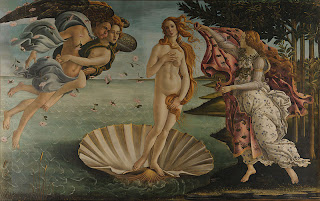 |
| Botticelli's The Birth of Venus Image from Wiki Commons |
The focal point of Botticelli’s The Birth of Venus is Venus herself, almost floating, in the center of the foreground with stark white skin; beams of light hitting her carefully painted curves. She is joined by Zephyrus, the wind God, his wife, Chloris, goddess of flowers, and the the nymph, Pomona, ready to receive Venus with a robe. Venus’ abnormally large proportions draw the eye of the viewer. With the curvature of her receivers, Venus is enclosed in an ovular shape, bringing unity to the piece. The expression on her face, as well as her pink hue, emphasise a youthfulness that reveals that she is emerging from the sea for the first time. To further her apparent modesty, Botticelli paints Venus covering herself with her arms and hair. The movement of Pomona’s garb depicts movement, as though she is running toward Venus to cover her and maintain her child-like modesty. Although Sephyrus is blowing the wind toward Venus, as if to beckon her, his robes blow in the opposite direction to further the importance of Venus’ arrival. Botticelli clearly uses line to his advantage in this piece. The implied line of the wind creates an overwhelming sense of movement. The detailed lines in Venus’ hair show her feminine structure. The background lay flat against the canvas, thus bringing all of the attention to the foreground. The most depth in the painting lies in the detailing of Venus’ body-- the definition in her stomach, face and hair. Another design element that Botticelli elegantly uses in this piece is color. The background is dark-- the sky looks as though a storm is coming; however, the foreground is brightened by a sun beam coming in from the right side of the painting, bringing a lightness and happiness to the painting. Botticelli’s The Birth of Venus illustrates articulate use line, color and expression.

